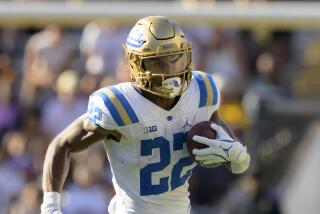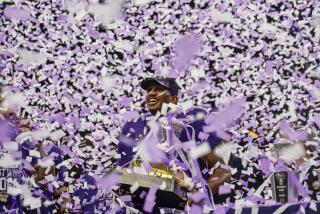College sports mascots extend the action well beyond the playing field
- Share via
College football’s clown princes — trees, tigers, hound dogs and something that resembles a giant hemorrhoid — have a culture all their own. Or maybe it’s an anti-culture. What’s the opposite of evolution? Devolution? Whatever the antonym, it is represented by this band of floppy deviants — pie-eyed and padded like a bomb squad.
America, meet your mascots.
Like the teams themselves, college mascots range from the polished — Oregon’s Duck and Auburn’s Tiger — to the downright scruffy. For example:
Maryland has a funny-looking something called Testudo — a turtle, apparently — though his name sounds like the lunch special at Taco Bell.
Idaho’s tough-looking Joe Vandal looks like a bouncer in a biker bar.
At Western Kentucky, they have what would politely be described as a blob. Or maybe a very personal wart.
Why do we love mascots? They seem so untroubled by it all. On occasion, you and I may be frozen between thoughts and deeds, but never a mascot. They are animated, edgy, comforting, proud. And as we approach the Bowl Championship Series title game, it’s hard to envision the matchup without these unsung heroes with the oversized heads and eyebrows the size of crows.
The mascot of the moment would be Oregon’s cantankerous and strutty Donald Duck knockoff, who will be performing Monday night when his school takes on Auburn, itself represented by a high-fivin’ Tiger (think Tony, of cereal fame) with an entourage and the smooth moves that garnered multiple national mascot titles.
The Duck is renowned, mostly, for doing a push-up for every point his high-scoring football team accumulates. Like body sweat or grade-point averages, the pushups are cumulative. In the game against New Mexico when Oregon scored 72 points, the Duck did 506 push-ups over the course of the contest.
Oregon picks four students to wear the Duck suit at athletic contests and events, though there is a lead Duck who works most of the football games. Tryouts are pretty informal. If students show an interest, they get a chance to show what they’ve got.
“We put them in the suit and send them to an event to see how they do,” says Dana Guthrie, an athletic department employee who oversees the cheer and mascot programs. “They have to have the same mannerisms … they have to be funny, they have to have a personality.”
Guthrie also designates the lead Duck based on showmanship (and push-up ability). Street dancing, skits, high-fives with the crowd are all part of the Duck tool kit. Each of the Duck mascots is free to come up with an individual routine. There are little things — movements, gags, spin moves, reactions — that set the four personas apart. Guthrie says she can tell who is whom by the shtick each performs.
The football Duck is developing new skits all the time. Props include weights, noise machines, light sabers. Among mascots, the Duck is known as particularly cheeky. If Oregon is winning big, he’ll bring out a lawn chair to demonstrate what a day at the beach the game has become. Auburn’s Tiger, known as Aubie, should be expecting almost anything.
“He has a Trojan outfit for when we play USC,” Guthrie says.
Among the mascot subculture’s quirks is an anonymity that rivals a witness-protection program’s. Most schools do not reveal the students’ names, in part to protect them from retribution but also so that students who might know the kid in the costume don’t come up shouting his name in the middle of a crowd, detracting from the mascot’s unique identity.
“I always tell people that mascots are the most unfamous famous people there are,” says Benji Gray, who stages mascot camps throughout the year for the United Cheerleaders Assn. and is a former full-scholarship mascot at Tennessee.
Full scholarships are rare, Gray says, and are mostly granted by football-crazed Southern schools. More common are partial scholarships or cash stipends that turn mascoting into a typical part-time campus job.
This adds to the fraternal feel among the mascots, several said, a mutual understanding of the challenges they face: heat, dehydration, low compensation, kids grabbing at their tails — all in the name of school pride.
“People have no idea,” says Old Dominion’s mascot Big Blue, a lion character. “It’s miserable. It’s the worst. It’s heaven.”
Gray says the temperature inside a typical mascot suit is 20 to 50 degrees warmer than the outside air.
The Duck suit weighs 30 pounds. It doesn’t breathe particularly well. And it is as absorbent as a pile of Pampers.
“I find it interesting when I check it into the airport for a game we’re going to, how much it weighs when I check it in,” says the anonymous student who plays the lead Duck. “Then on the way home, after I wore it, how much more it weighs with the sweat added on.”
On average, five to 10 extra pounds of Duck soup.
So, hydration is the key — he’s a Duck, after all. The lead Duck says he loads up before and during football games but rarely has to take bathroom breaks because he sweats out most of the water and sports drinks he consumes.
“It’s a very active and physically demanding job,” he says.
As branding tools go, a college mascot is tough to beat. A mascot can make a huge impression on a crowd, particularly among young kids in need of entertainment during a boring game. That kind of connection can last a lifetime, Gray says.
Then there is the training, which usually takes place with the cheerleading staff, many of whom are accomplished gymnasts. That’s what Oregon demands of the Duck, who says his weekly workout regimen includes weights and bench presses to keep his arms and shoulders in push-up shape. After a long day of classes, he’s off to the workout room at 5 p.m. three days a week, working with the male cheerleaders on upper body strength.
The student who plays Old Dominion’s Big Blue works out twice a week in the school’s athletic room with a professional trainer.
At Louisiana State, where it is routine to lose eight to 10 pounds during a game, the kids who wear the Tiger suit spend most of their practice time on cardiovascular workouts.
“The worst thing to happen would be passing out from the heat,” says Craig Pintens, an assistant athletic director who assists with LSU’s mascot program. “Mascots are trained to not speak and to never take off their head, which causes issues if you are struggling inside the suit.”
In some cases, there are open tryouts for the positions, but in the insular culture of mascots the honor is often handed down.
At Old Dominion, Big Blue was handpicked from a crowd by the outgoing student based on his impression of the new kid’s school spirit.
At Auburn, there are multiple clinics on how to be a mascot — including how to mime Tiger “emotions” — frustration, outrage, joy — leading up to open tryouts each spring.
Retro as a Ronald Reagan movie, mascots such as the Duck reflect an innocence that might have faded away long ago. Yet, their world is flourishing. Today, mascots attend camps, work as consultants, compete in nationwide contests, star in ESPN commercials … use Twitter, bleet, blog.
So, who are the best college mascots? Both of the characters in the BCS title game rank highly for their dance moves, their humor and their ability to inspire the crowd, says David Raymond, the original Phillie Phanatic and a guru in the world of mascots.
He’s always been impressed with Auburn, which has a committee of students who help with the mascot design and make props and create skits. Aubie the Tiger is known as a particularly good dancer, Raymond says.
Then there’s that ubiquitous Duck — again.
“Oregon has done a great job in taking a rather common duck character and getting the most out of it,” Raymond says, citing the mascot’s distinctive personality and edge.
Gray, who oversees the contest to pick the mascot of the year each season, cites his alma mater, Tennessee, as well as Alabama and Delaware as places where mascot performances are particularly appealing and professional.
But polished presentations and pro-caliber dance moves aren’t the only things that catch the experts’ eyes.
When Stanford failed to come up with a mascot, the marching band provided one instead. What occurred is the Tree — a shaggy, bug-eyed spoof of other mascots. It was adopted over other candidates, including a steaming manhole cover.
“It’s a horrible-looking mascot, let’s face it,” says Raymond, who heads a company that consults on college and pro mascots. “It takes a lot of guts to make fun of themselves like that.
“I enjoy the effort, even if it’s not what we usually represent.”
Emotions can run high on the sidelines — call it mascot rage. In September, Rufus the Bobcat tackled Ohio State’s Brutus Buckeye, and the Ohio University student was later relieved of his mascot duties. In December, Cincinnati’s Bearcat was cited for disorderly conduct after throwing snowballs at fans during a game.
And three years ago, Oregon’s Duck drew a one-game suspension after pouncing on the Houston Cougar for mocking him/her/it.
After a 12-0 season, things seem less confrontational in Oregon these days — maybe it’s all those pushups.
So we asked the Duck: Who’s the toughest mascot in the Pacific 10 Conference? You?
“If by toughest you mean ‘dashingly handsome,’ then yes,” says the Duck. But he cites USC’s Tommy Trojan as the toughest, at least in the Pac-10.
“He has a sword, and all I have are feathers,” the Duck says.
Actually, Tommy Trojan is a statue.
But the drum major carries a sword.
More to Read
Go beyond the scoreboard
Get the latest on L.A.'s teams in the daily Sports Report newsletter.
You may occasionally receive promotional content from the Los Angeles Times.











